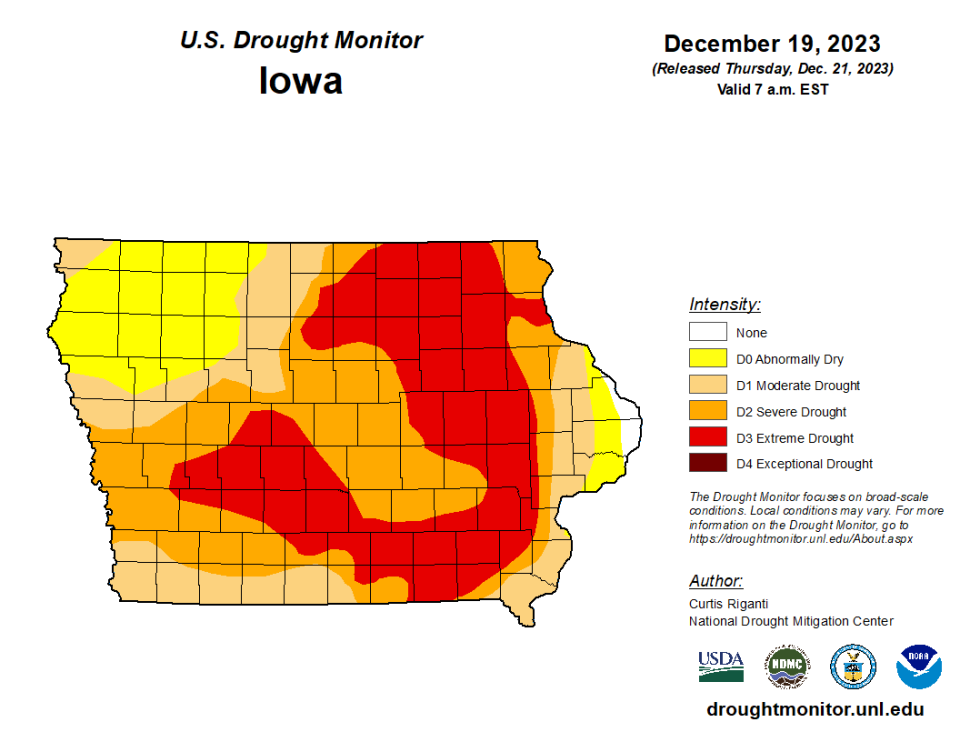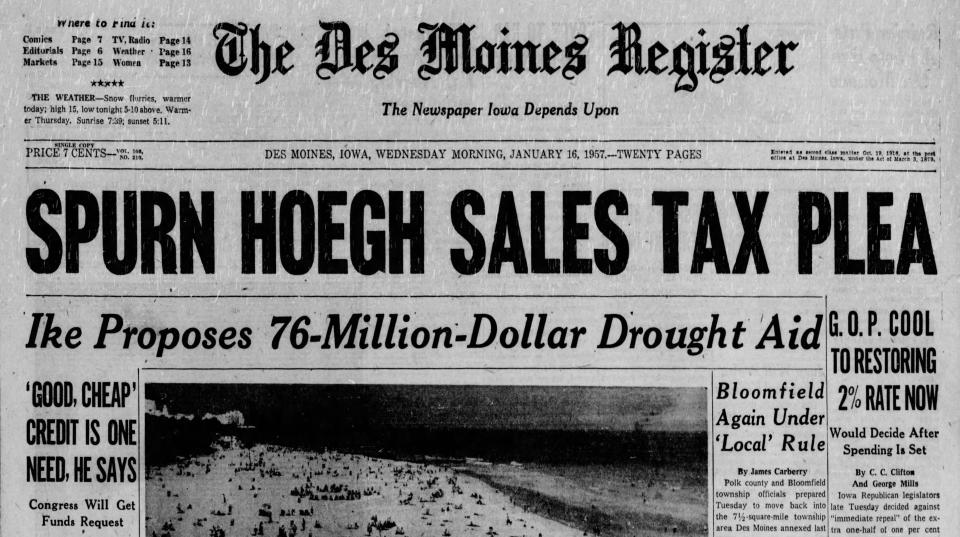At 188 weeks, Iowa's drought is the longest since the 1950s, state climatologist says
About four-fifths of Iowa is gripped in a drought that's now become the state's longest since the 1950s, new reports show.
According to the latest update of the U.S. Drought Monitor, 84% of Iowa is experiencing drought, with 35% of the state, including much of the Des Moines metro, gripped in extreme drought.
Some relief could be on the way, with Iowa forecast to get 1 to 1½ inches of rain over the next week, according to the National Weather Service. But “it’s by no means a drought buster,” said Justin Glisan, Iowa’s state climatologist.

Tim Hall, an Iowa Department of Natural Resources hydrologist, agreed.
“The reality is we're 8, 9, 10 inches short of rain in some parts of the state, just this year,” Hall said.
Iowa’s precipitation deficit over four years has climbed to nearly 28 inches, Glisan said ― only 7 inches short of an average year of Iowa rainfall.
“We need several months, if not more than a year, of above-average precipitation to put a dent in the longer-term” shortfall, Glisan said.
He said that at 188 weeks, as calculated from Drought Monitor data, this is the longest drought in Iowa since one that stretched from December 1954 to November 1958.

While drought encompasses large parts of the Midwest, including Kansas, Minnesota and Missouri, Iowa is “suffering the most,” Steve Vavrus, the Wisconsin state climatologist, said in a media briefing Thursday sponsored by the National Oceanic and Atmospheric Administration, the U.S. Department of Agriculture and other partners.
Vavrus said officials are warning that persistent drought could cause wildfires next spring in Iowa, Minnesota, Wisconsin and Missouri.
“People are keeping an eye on what our winter drought means for spring,” he said.
Farmers encouraged to take moisture conservation step
The continued drought could spell trouble for Iowa and other Midwest farmers.
With 3½ years of drought, “We’ve removed most of the moisture from the soil,” said Dennis Todey, director of the USDA Midwest Climate Hub in Ames. “We need multiple rainfalls this winter and spring to refill that soil moisture profile.”
The coming rain in Iowa should be quickly absorbed, said Hall and others.
"Putting some moisture in the tank banks it for next growing season," Glisan said.
In the past couple of years, many farmers reported getting needed rain at critical growing stages, such as when corn plants tassel, helping producers get better-than-expected yields despite the drought. But Todey is urging farmers to take precautions by refraining from tilling their fields.
“We actively encourage people to reduce tillage anyway, but even moreso during dry conditions,” he said. “Every tillage pass costs you moisture.”
More: Drier than the Dust Bowl: Iowa, facing more drought, preps for water shortages
He said farmers may need less fertilizer as well, if drought means less-than-maximum yields: "It's going to be wasted."
DNR hydrologist: 'We’ll take any drop we can get'
While the prevailing El Nino weather pattern typically means warmer and dryer winters, Glisan said six of the past seven strong systems in Iowa have been wetter than average over the winter. That’s encouraging, but winter typically brings the state’s driest months, so the benefits are limited, he said.
Most of Iowa’s rainfall comes from April to July, so above-average rainfall during those months is the most beneficial, Hall said.
“Those are the months that have the potential to get things a lot better — or a lot worse,” he said. “Any moisture we get over the winter is welcome — and we’ll take any drop we can get — but I’m hoping we get above average rainfall in those wetter months of April, May, June and July.”
Vavrus said low water levels caused by the drought continue to slow barges moving grain and other products along the Mississippi River. "Dredging is becoming a very big need in order to keep the barge traffic flowing," he said.
Hall said the forecast rain will help Iowa cities like Osceola, which is struggling with dwindling water supplies. West Lake, the city's source of drinking water, has fallen 6.7 feet below its normal levels due to persistent drought.
The southern Iowa community is encouraging residents to use bottled water to conserve dwindling city supplies, and officials have ask state regulators for permission to use treated wastewater to help recharge West Lake. If that request is granted, Osceola would be the state’s first city to recycle treated wastewater to boost drinking water supplies.
"It's been an exceptionally long stretch of very dry weather. So this rain would be very, very welcome," Hall said.
Donnelle Eller covers agriculture, the environment and energy for the Register. Reach her at deller@registermedia.com or 515-284-8457.
This article originally appeared on Des Moines Register: At 188 weeks, Iowa's drought is the longest since 1950s, state says

